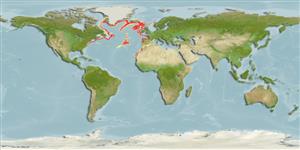Teleostei (teleosts) >
Perciformes/Zoarcoidei (Eelpouts and pricklebacks) >
Zoarcidae (Eelpouts) > Gymnelinae
Etymology: Melanostigma: Greek, melan, -anos = black + Greek, stigma = signal (Ref. 45335).
Environment: milieu / climate zone / depth range / distribution range
Ecology
Marine; bathypelagic; depth range 400 - 1853 m (Ref. 58426). Deep-water; 74°N - 19°N, 77°W - 6°E
Northwest Atlantic: New Brunswick in Canada to Virginia in USA. Eastern Atlantic: Off the western coast of Scotland and in the Mediterranean (Gulf of Genoa; also off Spain) (Ref. 4695), Faeroe-Iceland Ridge and between Cap Blanc, Mauritania and the Canary Islands (Ref. 6950).
Size / Weight / Age
Maturity: Lm ? range ? - ? cm
Max length : 15.0 cm TL male/unsexed; (Ref. 7251)
Occurs in midwater over the continental slope. Mostly found from 365-550 m depth, but enters shallower water in the northern part of range (Ref. 7251); prefers salinity of 33.4-34.7 ppt. (Ref. 5951). Bathypelagic (Ref. 58426). Feeds on foraminifera, copepods, and ostracods (Ref. 9731).
Life cycle and mating behavior
Maturity | Reproduction | Spawning | Eggs | Fecundity | Larvae
Robins, C.R. and G.C. Ray, 1986. A field guide to Atlantic coast fishes of North America. Houghton Mifflin Company, Boston, U.S.A. 354 p. (Ref. 7251)
IUCN Red List Status (Ref. 130435: Version 2024-2)
Threat to humans
Harmless
Human uses
Tools
Special reports
Download XML
Internet sources
Estimates based on models
Preferred temperature (Ref.
123201): 3.3 - 10.6, mean 5.8 °C (based on 143 cells).
Phylogenetic diversity index (Ref.
82804): PD
50 = 0.5039 [Uniqueness, from 0.5 = low to 2.0 = high].
Bayesian length-weight: a=0.00316 (0.00135 - 0.00739), b=3.15 (2.94 - 3.36), in cm total length, based on LWR estimates for this (Sub)family-body shape (Ref.
93245).
Trophic level (Ref.
69278): 3.0 ±0.0 se; based on diet studies.
Resilience (Ref.
120179): Medium, minimum population doubling time 1.4 - 4.4 years (Assuming tmax>3; Fec=43).
Fishing Vulnerability (Ref.
59153): Low vulnerability (10 of 100).
Nutrients (Ref.
124155): Calcium = 59.6 [18.9, 140.1] mg/100g; Iron = 0.394 [0.163, 1.137] mg/100g; Protein = 17 [14, 19] %; Omega3 = 0.155 [0.053, 0.418] g/100g; Selenium = 15.5 [4.9, 43.6] μg/100g; VitaminA = 38 [4, 331] μg/100g; Zinc = 0.825 [0.441, 1.627] mg/100g (wet weight);
